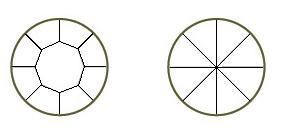A single-cut diamond refers to an old-style cut that features only 16 facets in total – 8 on the crown (the top portion of the diamond) and 8 on the pavilion (the lower portion). This style of diamond cutting is one of the earliest methods used in diamond cutting history and was prevalent before more advanced cuts like the brilliant cut became popular.
The single-cut diamonds were originally designed to make the most of the available diamond rough, often with the goal of enhancing the sparkle of small stones. The limited number of facets (compared to modern cuts) results in a simpler appearance, but they still display a degree of brilliance when well-cut.
Key Features of Single-Cut Diamonds:
Facets: The single-cut diamond typically has 16 facets – 8 on the crown and 8 on the pavilion, making it less complex than the round brilliant or emerald cut, which have far more facets.
Size and Sparkle: This style of cut is typically used for small diamonds. Despite the simpler facet structure, a well-cut single-cut diamond can still display sparkle, though it will not exhibit the intensity of light return seen in more modern cuts.
Historical Significance: The single cut was one of the first attempts at enhancing the natural sparkle of a diamond and was the preferred cut for small diamonds in vintage jewellery. It is still sometimes used today for very small diamonds (such as those used in mosaic or pavé settings), where a smaller, simpler cut is sufficient.
Modern Use: Although modern diamond cutting techniques now dominate, the single-cut remains relevant in certain instances, especially for tiny accent diamonds in vintage-inspired designs or budget-friendly pieces. This cut tends to be affordable due to the simplicity and fewer facets involved in the cutting process.
Appearance: The look of a single-cut diamond is generally less brilliant than a modern round brilliant cut, as it has fewer facets to interact with light. However, it still offers a certain charm, particularly in smaller sizes, where the increased facet count of larger stones may not be necessary.
Other Names:
The single-cut diamond is also referred to as an eight cut, which describes the eight facets on each side (crown and pavilion), emphasising its simplicity compared to the more complex, modern diamond cuts.
While not as commonly used for larger stones today, the single cut holds a place in history and is cherished in vintage and antique jewellery, often offering a nostalgic, traditional look for those seeking a more classic style.

